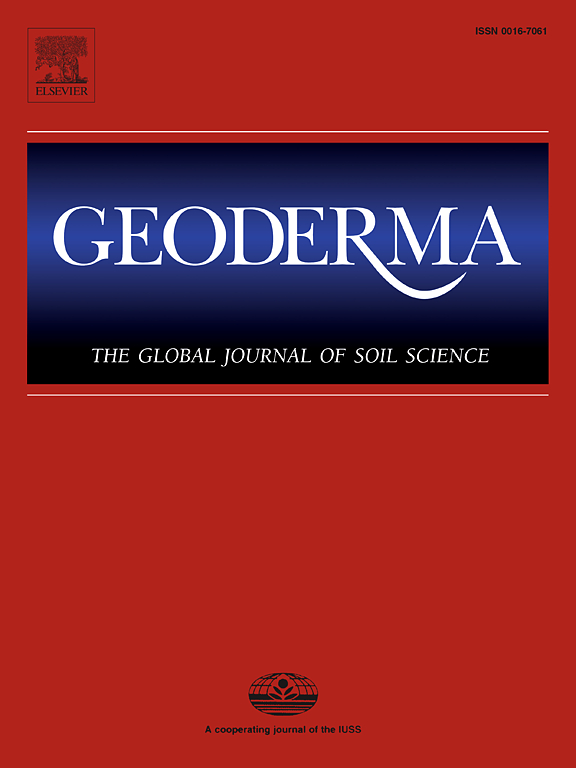萨斯喀彻温省不同农业土壤有机碳和全氮FT-NIR预测的全局-局部建模方法的性能
IF 6.6
1区 农林科学
Q1 SOIL SCIENCE
引用次数: 0
摘要
精准农业需要一种可靠、经济的方法来测量土壤有机碳(SOC)和总氮(TN),傅里叶变换近红外(FT-NIR)光谱提供了一种有前途的解决方案。本文采用Global-Local模型改进了萨斯喀彻温省农业土壤土壤有机碳和全氮的FT-NIR预测。土壤样品(SOC: n = 1876;TN: n = 1442)于2020年和2021年从萨斯喀彻温省六个农业区收集。获取光谱数据,使用连续小波变换(CWT)进行预处理,并使用立体回归建模。Global-Local模型通过将来自萨斯喀彻温省光谱数据集的一小部分特定地点样本(Lab)与它们的k近邻(Neighbour)相结合来应用。将其性能与Leave-One-Site-Out (LOSOV)、site specific、Lab、Neighbour和传统spike进行了比较。与LOSOV模型(SOC: R2 = 0.55 ~ 0.76, CCC = 0.67 ~ 0.79, RPD = 1.20 ~ 1.44)相比,站点特定模型的性能更高(SOC: R2 = 0.71 ~ 0.88, CCC = 0.82 ~ 0.92;RPD = 1.59 - 2.70)。Global-Local模型比LOSOV表现更好,并且与最好的Lab或Neighbour模型表现相似。与Global-Local相比,由于目标变量和光谱数据集具有更高的可变性,传统的峰值方法要么改进了结果,要么给出了相似的结果。使用峰值或全局局部比LOSOV更准确的模型证实了将特定地点样本纳入训练数据集的重要性。我们的研究结果表明,全局局部模型的应用应局限于单个领域的水平,这是其最初的目的。未来需要对全局局部模型进行优化研究,以扩大其应用范围。本文章由计算机程序翻译,如有差异,请以英文原文为准。

Performance of the Global-Local modelling approach for FT-NIR predictions of SOC and TN in diverse Saskatchewan agricultural soils
Precision agriculture requires a reliable, cost-effective method to measure soil organic carbon (SOC) and total nitrogen (TN), and Fourier Transform Near Infrared (FT-NIR) spectroscopy offers a promising solution. Here, we applied the Global-Local model to improve FT-NIR SOC and TN predictions in Saskatchewan agricultural soils. Soil samples (SOC: n = 1876; TN: n = 1442) were collected in 2020 and 2021 from six Saskatchewan agricultural regions. Spectral data were acquired, preprocessed using continuous wavelet transform (CWT), and modelled using Cubist regression. The Global-Local model was applied by combining a small subset of site-specific samples (Lab) with their k-nearest neighbours (Neighbour) from Saskatchewan spectral datasets. Its performance was compared with Leave-One-Site-Out (LOSOV), site-specific, Lab, Neighbour, and traditional spiking. Compared to LOSOV (SOC: R2 = 0.55 – 0.76, CCC = 0.67 – 0.79, RPD = 1.20 – 1.44), site-specific models gave higher performance (SOC: R2 = 0.71 – 0.88, CCC = 0.82 – 0.92; RPD = 1.59 – 2.70). The Global-Local model performed better than LOSOV and performed similarly to the best Lab or Neighbour models. Compared to the Global-Local, traditional spiking either improved or gave similar results due to higher variability in target variable and spectra datasets. The more accurate models using either spiking or Global-Local than LOSOV confirms the importance of incorporating site-specific samples into training datasets. Our results indicate that the application of the Global-Local model should be restricted to an individual field level, which was its original purpose. Future studies on optimization of the Global-Local model is needed to scale-up its application.
求助全文
通过发布文献求助,成功后即可免费获取论文全文。
去求助
来源期刊

Geoderma
农林科学-土壤科学
CiteScore
11.80
自引率
6.60%
发文量
597
审稿时长
58 days
期刊介绍:
Geoderma - the global journal of soil science - welcomes authors, readers and soil research from all parts of the world, encourages worldwide soil studies, and embraces all aspects of soil science and its associated pedagogy. The journal particularly welcomes interdisciplinary work focusing on dynamic soil processes and functions across space and time.
 求助内容:
求助内容: 应助结果提醒方式:
应助结果提醒方式:


